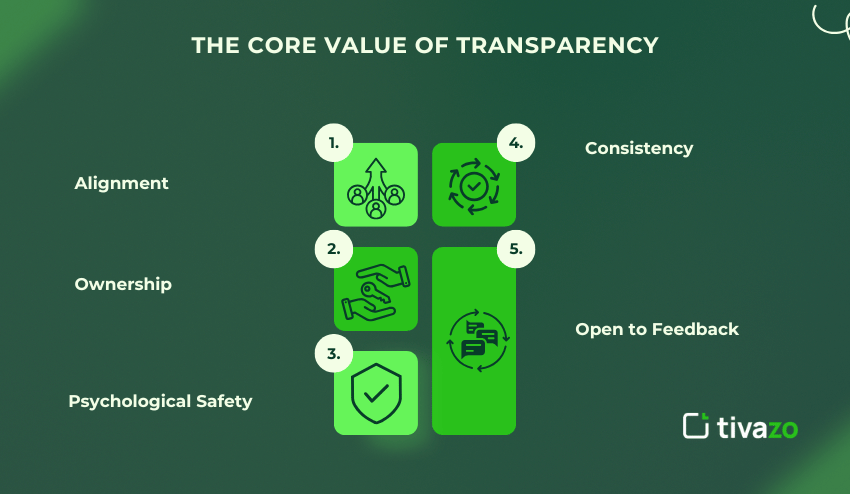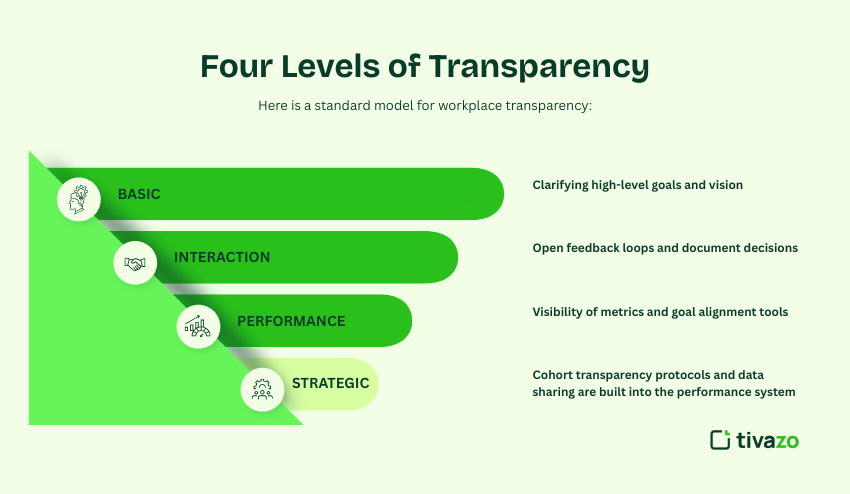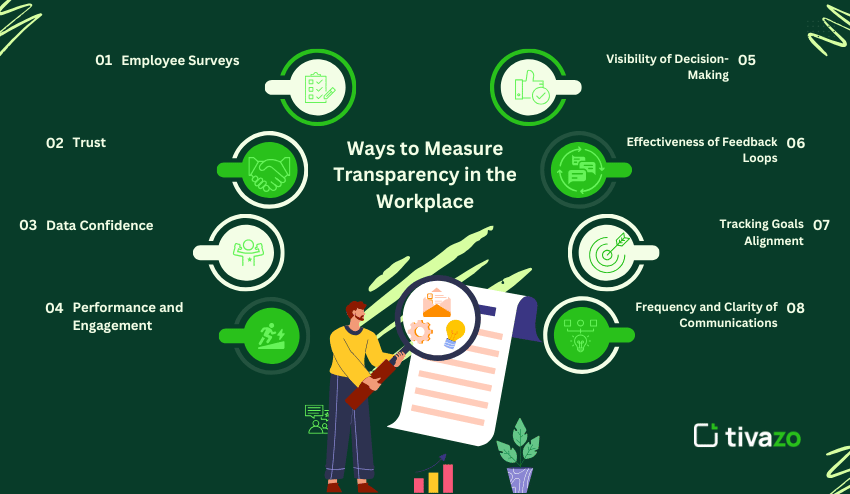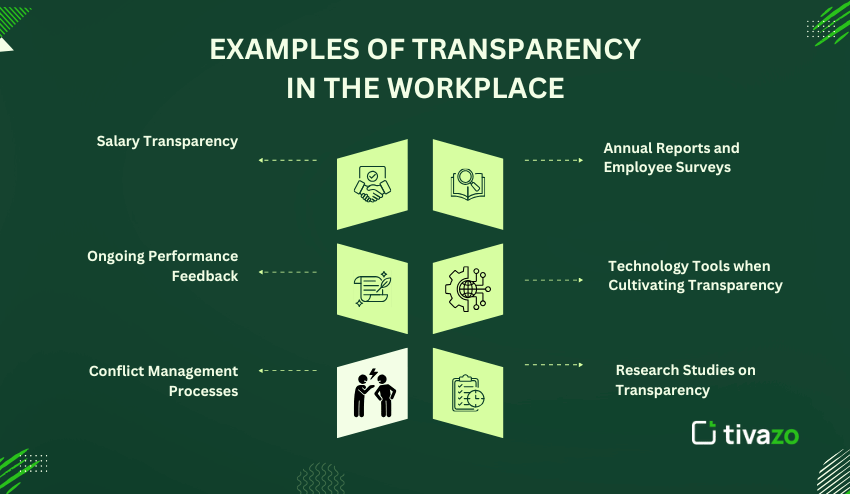Building trust, maximizing productivity, and encouraging employee engagement all begin with transparency in the workplace. When teams work in a transparent environment, there’s an urge to openly communicate, demonstrate accountability, and focus on building meaningful relationships—all of which can reliably contribute to workplace transparency and develop a culture of openness and trust. Ultimately, this yields value as employees feel valued, well informed, and motivated to take responsibility for their performance and impact with their colleagues.
In this guide, we will discuss what it means to be transparent in the workplace, why being transparent is a building block of organizational success, strategies you can use to maintain transparency in the workplace, and how you can measure its outcome in practice. We will examine the four levels of transparency, show examples from top companies, flag behavioural indicators of poor transparency, and list some actionable steps you can take to create your form of transparency in the workplace, which leads to trust, performance, and long-term business value.
Key Highlights:
- What is Workplace Transparency?
- The Core Value of Transparency
- Four Levels of Transparency
- How to Create Organizational Transparency
- Ways to Measure Transparency in the Workplace
- Indicators of a poorly managed, non-transparent workplace
- Examples of Transparency in the Workplace
- What does it mean to trace a deficit of transparency?
What is Workplace Transparency?
Workplace transparency means more than merely sharing information; it is about creating a culture in which employees at all levels have access to the knowledge, goals, and rationale of decisions. This includes leaders openly communicating about the company’s goals, performance, challenges, and opportunities, while welcoming feedback from employees. True workplace transparency breaks down silos, creates fewer misunderstandings, and facilitates trust between management and employees. When teams understand the why behind strategies, they are more engaged, motivated, and aligned with the organization.
Transparency also creates accountability – everyone can see the role they have to play, the responsibilities they stand for, and the progress they are making against common goals. Workplace transparency can include shared financial results, publishing the minutes from meetings, performance metrics visible to the organization, and openly discussing plans for the business.
Sharing information strengthens trust and generates a sense of openness, inclusivity, and belonging, allowing employees to feel they are part of the bigger picture, sense of ownership, and to help contribute to a company’s success.
The Core Value of Transparency
Trust is the core value that underpins workplace translates; trust is the foundation of all healthy, high-impact organizations. When trust exists, employees feel safe sharing ideas, expressing concerns, and collaborating effectively. This leads to better decision-making, higher levels of engagement, and a greater sense of belonging.
The key ways workplace transparency builds trust include:
- Alignment – when transparency exists, organizations make sure every employee understands the company’s goals and how their work contributes to those objectives.
- Ownership – employees feel empowered to own their work and to own the results of that work.
- Psychological Safety – it creates a psychological environment where people feel safe speaking truth, no matter how productive or amicable it may be to leadership.
- Consistency – transparency establishes credibility when the words of leadership match the actions of leadership.
- Open to Feedback – when leadership is transparent, it establishes and maintains its willingness to value the voice of employees.
When organizations establish workplace transparency at the front end of their operating practices, it builds the foundation of the organization’s culture of honesty and respect. As the culture develops honest and respectful communication, you allow for more innovation and production while creating a long-term, successful organization.

Four Levels of Transparency
Here is a standard model for workplace transparency:
| Number | Level | Description |
| 1- | Basic | Clarifying high-level goals and vision |
| 2- | Interaction | Open feedback loops and document decisions |
| 3- | Performance | Visibility of metrics and goal alignment tools |
| 4- | Strategic | Cohort transparency protocols and data sharing are built into the performance system |

How to Create Organizational Transparency
- Clearly define workplace transparency – Be sure everyone knows what workplace transparency means for your organization.
- Over-communicate and consistently communicate – Surprises are bad. Update team members and make them aware of anything and everything happening.
- Create accountability through equal rules – Apply the same rules and expectations for everyone.
- Solicit feedback and document decisions – Create open channels for feedback and keep documentation of the important things you did.
- Introduce some goal-alignment software to create visibility – You want employees to have visibility to objectives (the company’s as well as their own) and progress.
- Be a role model – Managers must have transparent behaviors in their business dealings every day.
Communicate, reflect, and renew workplace transparency expectations – Use surveys and feedback to showcase possible enhancements and improve trust!
Ways to Measure Transparency in the Workplace
Employee Surveys
Consistently, gauge your employees as to how well they understand your company’s goals, decisions, and processes. Questions should determine if employees feel included and informed. The good news is, research shows that 92% of employees perform better when goals are visible, and 37% improve when they understand coworkers’ goals. These data points show the effectiveness of your workplace transparency efforts.
Trust
Measure how trustworthy employees feel leadership is and the trust in how communication is shared or demonstrated with employees. Deloitte states that 86% of leaders say transparency is the building block to creating trust. You can assess the level of trust with pulse surveys, one-on-one interviews, or by using software and listening tools to detect how transparent employees view the workplace to be.
Data Confidence
Transparency is also about being transparent about how employee and company data is being used. Currently, only about 37% of employees trust their organizations’ usage of data. With that in mind, measuring employees’ confidence in data privacy and usage identifies transparency opportunities for improvement when there is a lack of clarity around communicating data policies clearly.
Performance and Engagement
Keep track of key performance indicators, including but not limited to employee engagement, retention rates, and productivity. Studies show that workplace transparency can drive an increase in engagement and/or a decrease in turnover. Tracking the trends of such metrics over time will help connect transparency efforts to organizational performance or business outcomes
Visibility of Decision-Making
Assess the degree to which decisions are communicated across teams. Are meeting notes shared? Are the rationales and next steps transparent? Measuring this could include qualitative feedback and audit trails to assist in making informed decisions.
Effectiveness of Feedback Loops
Evaluate the effectiveness with which employee feedback loops are established and acted upon. A workplace transparency emphasizes dialogue. Measuring the quantity and quality of feedback and actions taken afterwards provides insight into a transparent culture.
Tracking Goals Alignment
Leverage available software systems to assess how transparently team and individual goals align with company goals. The degree of transparency into a real-time view of goal progress is a direct measure of workplace transparency and ensures everyone understands their role in achieving the success of the organization.
Frequency and Clarity of Communications
Assess the frequency and transparency of communication with employees by leadership. Transparency occurs with ongoing and clear communication at every level. Monitoring email updates, town halls, and intranet activity from leadership will expose any undetected gaps that exist.
By using these methods of analysis, an organization can assess how transparently they have assessed and identified gaps to further advance in the opportunity to deepen openness, trust, and engagement.

Indicators of a poorly managed, non-transparent workplace
- Frequent confusion regarding decision-making and expectations: Employees are confused about what is expected of them or the reasoning behind decisions made, which can cause frustration.
- No documentation or clarity around reasons for decisions, nor unclear expectations: There is an absence of any reliable documentation or communication that outlines why choices are made, or what is expected of roles.
- No mechanisms for feedback or communication taboo: Employees believe there is no opportunity to voice opinions or raise issues without fear of retribution.
- Obvious disconnect between leadership communications and actions: Leaders say one thing and do another, which only impedes trust.
- Narrowly selected information sharing by management: Important updates and other data are selectively shared, which creates gaps in the information – this lack of transparency and openness results in resentment from employees.
- Communication inequity: Some employees or team members receive more information or opportunities than others.
- Employee turnover and lack of morale: Lack of transparency does damage, people leave, and lose motivation.
- Resistance to change: By not communicating effectively, there is resistance to new initiatives/processes.
These indicators reinforce a lack of transparency, and trust can severely undermine relationships, trust, and engagement across the group.
Examples of Transparency in the Workplace
1. Salary Transparency
One example of workplace transparency is salary transparency, whereby companies publicly disclose pay ranges and/or individual salaries. Salary transparency can close pay gaps, foster trust in leadership, and convey an overall commitment to fairness.
2. Ongoing Performance Feedback
Another example of workplace transparency is to create an environment in which staff routinely get honest performance feedback. Ongoing assessment (as opposed to only annual reviews) creates the opportunity for clarity, communication, and personal growth.
3. Conflict Management Processes
Transparency in conflict management processes helps organizations be open about conflict rather than keeping the issues bottled up or silenced.
4. Annual Reports and Employee Surveys
Many organizations prepare annual reports and conduct employee surveys to inform employees of the organizational health of the company and elicit honest feedback to foster organizational transparency.
5. Technology Tools when Cultivating Transparency
There are technology platforms that can help your organization foster workplace transparency, such as Betterworks. These platforms offer goal alignment, their use of real-time feedback adds transparency, and employees have tools to provide feedback to the organization. These systems will document/track shared company goals and create transparency in the progress on projects by conveying what is important to the company to its employees. Accountability and trust are the two notable primary functions that follow these visibility and transparency practices.
6. Research Studies on Transparency
Deloitte studies indicate that workplace transparency, particularly in the area of data sharing and decision making, creates a human-centered workplace or culture, which fosters respect and positive employee engagement, motivation, and enhanced workplace performance, innovation.

What does it mean to trace a deficit of transparency?
- It cultivates confusion and frustration: By withholding information (or sharing only partial information), employees will feel confused about the basis for decisions and where it is all going.
- It undermines trust: The lack of transparency creates mistrust, creating rifts between leadership and employees, which undermines the working relationships between them.
- It lowers morale and commitment: Employees will feel disengaged from their role and more hesitant to share their ideas or feedback.
- It accelerates rumors and misinformation: When people only have limited information available, speculation creeps in, and a toxic culture is fostered in the place of information.
- It limits innovation: When team members can’t easily access the right information conveyed promptly, it is difficult for the team to collaborate or problem solve.
- It inhibits accountability: A lack of workplace transparency inhibits accountability – it’s not possible to hold people accountable if they weren’t aware of the issues with their performance or the expected outcomes.
- It increases turnover: Frustrated and disconnected employees are less likely to stay with the organization.
Addressing the lack of transparency is a required piece of work to build trust, enhance engagement, and ensure future success.
Conclusion
In a world characterized by fast-paced environments, transparency in the workplace is critically important. Transparency occurs when an organization provides clear communications, accountability for their promise, and regularly audits their transparency. In organizations that value transparency, a culture of openness flourishes, where employees feel an increased sense of value and knowledge within the workplace. Transparent organizations also use and experience their transparency as pillars of trust, engagement, and productivity over the pitfalls of mistrust and confusion.
In short, using good, strong transparency practices is not just a choice of organizational leaders; it is a requirement for a successful strategy in the workplace, which provides for better decision making, creativity and innovation, and sustainability. It is time to create workplace environments that promote high performance through the use of transparency practices.




